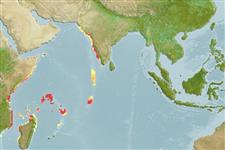Classificação / Names
Nomes comuns | Sinônimos | Catalog of Fishes(Gênero, Espécies) | ITIS | CoL | WoRMS | Cloffa
>
Eupercaria/misc (Various families in series Eupercaria) >
Labridae (Wrasses)
Etymology: Paracheilinus: Greek, para = the side of + Greek, chaite = hair + Greek, odous = teeth (Ref. 45335); attenuatus: From the Latin attenuatus meaning drawn out or tapering, in reference to the shape of the caudal fin..
More on author: Randall.
Environment: milieu / climate zone / depth range / distribution range
Ecologia
marinhas demersal; intervalo de profundidade 21 - 50 m (Ref. 41634). Tropical
Western Indian Ocean: known only from one atoll of the Amirante Islands in Seychelles and one specimen from the aquarium trade from Kenya.
Tamanho / Peso / Idade
Maturity: Lm ? range ? - ? cm
Max length : 6.0 cm SL macho/indeterminado; (Ref. 41634)
Descrição suscinta
Chaves de identificação | Morfologia | Morfometria
Espinhos dorsais (total) : 9; Raios dorsais (total) : 11; Espinhos anais: 3; Raios anais : 9; Vértebras: 25. Median predorsal scales 5; horizontal scale rows on cheek below eye 2; body depth 3.2-3.55 in SL; ; head length 2.9-3.05 in SL; snout length 3.9-4.1 in HL; first dorsal soft ray of adults long and filamentous; caudal fin rounded in young, lanceolate with strongly concave upper and lower posterior margin in adults, the fin length 2.9-3.6 in SL; pelvic fin short, 1.6-1.8 in HL. Adult males in life light orange, shading to yellow ventrally, with four longitudinal lavender bands on body which link to three narrow lavender bands extending posteriorly from eye; dorsal fin yellow with a broad blue-edged red zone posteriorly in fin, the filament red. Small females with the same but narrower stripes, dark-edged blue lines dorsally on head, a large dark brown spot at base of dorsal fin below juncture of spinous and soft portions, and a small dark brown spot dorsoposteriorly on caudal peduncle.
Found over rubble or hard bottom (Ref. 41634). Largest size recorded is 6.58 mm SL from the aquarium trade (Ref. 41634).
Ciclo de vida ou comportamento de acasalamento
Maturities | Reprodução | Spawnings | Egg(s) | Fecundities | Larvas
Oviparous, distinct pairing during breeding (Ref. 205).
Randall, J.E., 1999. Paracheilinus attenuatus, a new labrid fish from the western Indian Ocean, with a redescription of P. piscilineatus . J. South Asian Nat. Hist. 4(1):29-38. (Ref. 41634)
Status na Lista Vermelha da UICN (Ref. 130435)
Ameaça para os humanos
Harmless
Uso pelos humanos
Pescarias: espécies comerciais; Aquário: Espécies comerciais
Ferramentas
Relatórios especiais
Baixar XML
Fontes da internet
Estimates based on models
Preferred temperature (Ref.
123201): 26 - 27, mean 26.7 °C (based on 6 cells).
Índice de diversidade filogenética (Ref.
82804): PD
50 = 0.5000 [Uniqueness, from 0.5 = low to 2.0 = high].
Bayesian length-weight: a=0.00955 (0.00456 - 0.02002), b=3.06 (2.89 - 3.23), in cm total length, based on LWR estimates for this (Sub)family-body shape (Ref.
93245).
Nível Trófico (Ref.
69278): 3.4 ±0.4 se; based on size and trophs of closest relatives
Resiliência (Ref.
120179): Elevada, tempo mínimo de duplicação da população menor que 15 meses (Preliminary K or Fecundity.).
Fishing Vulnerability (Ref.
59153): Low vulnerability (10 of 100).
